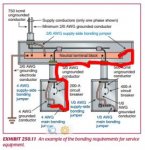Ladies and Gents,
Please see the attached marked up image that supposedly represents an acceptable service installation with multiple disconnects. It appears the main bonding jumper bonded to the enclosure could cause a parrallel path for neutral current as indicated in the red highlighted path (others could be drawn). Is there some exemption to 250.6 that I am not aware of for service equipment. If the main bonding jumper was brought to the neutral bus in the gutter then I don't believe there would be objectionable current. Please advise.

Thanks
Please see the attached marked up image that supposedly represents an acceptable service installation with multiple disconnects. It appears the main bonding jumper bonded to the enclosure could cause a parrallel path for neutral current as indicated in the red highlighted path (others could be drawn). Is there some exemption to 250.6 that I am not aware of for service equipment. If the main bonding jumper was brought to the neutral bus in the gutter then I don't believe there would be objectionable current. Please advise.

Thanks

